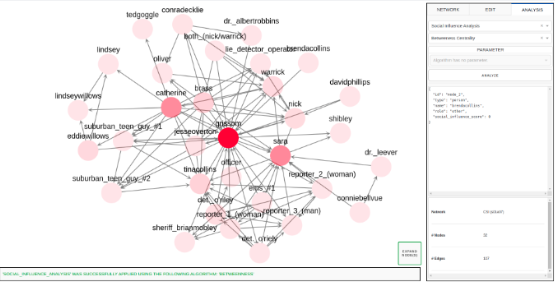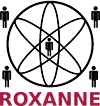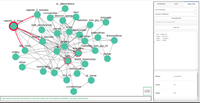ROXANNE platform & network analysis
Briefly, network analysis is the process of uncovering hidden patterns regarding the behavior and relations among individuals in networks using a wide range of computational and statistical methods. Examples of those patterns are the distribution of relations among the individuals, the underlying factors that determine the relations, and cohesive groups of individuals with dense relations. These methods have been applied in various domains of daily life, including economics, biology, and sociology [1, 2], and particularly security and criminology [3, 4, 5]. In this post, we present the analyses that are most closely related to the ROXANNE project.
- Social influence analysis
Certain individuals have more influence over the others within a social network. To measure the influence of a particular individual, several approaches can be used, such as: Degree - number of links to other individuals, Closeness - measure of how close the targeting individual is to all other individuals (in number of hops), or Betweenness - the number of times the targeting individual lies on the shortest path between pairs of other individuals. - Community detection
Very often, individuals within a network tend to form communities. Each community is a cohesive group of individuals whose intra-community interaction is denser and more frequent than their interaction with the rest of the network. In this task we aim to uncover those hidden structures using interactions among network individuals and their associated information, e.g. attributes and meta-data. - Link prediction
In practice, people interact and communicate with each other through many channels which are not always observable. Hence, many interactions and relations among individuals in a network are hidden or not observed. Moreover, the network evolves over time; new interactions and relations are constantly added into the network. In this task, we aim to uncover these missing or hidden, unobserved interactions and relations in the network, as well as to predict the most probable ones to be formed in the near future. - Outlier detection
Generally, in a large dataset, an outlier is defined as a data point which is very different from the rest of the dataset. Here, the difference is often determined by some statistical measures which are specifically tailored to the context and domain of the dataset. Those outliers often contain useful information on irregular elements or strange behavior of the system or population that the dataset describes.
- A CASE STUDY ON ROXANNE DATASETS
We built a dataset, called 'CSI networks', which is a collection of conversational networks among characters in select episodes of the CSI: Crime Scene Investigation series. We have run extensive experiments on this dataset and extracted “who talked to whom” information from the videos.

https://www.youtube.com/watch?v=EhYpXgJUNSk
Figure 1. A preview of the episode 'Sqweegel' on CSI
Based on this information, we have constructed a network among 14 main characters from one episode (Season 1, Episode 7) with 60 links, in which each link shows that two characters have been involved in some conversation. Another similar network is also extracted from the transcripts with 30 characters of the same episode and 107 links.
Figure 2 shows the visualization of social influence analysis on a CSI network using the betweenness measure. It can be observed from the figure that “Grissom” is the most important individual in the network by this measure. This is reasonable and highly expected as he is the leader of the investigation team and should be in the center of most conversations among the characters in the series.

Figure 2. Social influence analysis on a CSI network using betweenness measure
Figure 3 shows the visualization of link prediction on a CSI network for reporter_3 where the individual is predicted to have latent links with reporter_1, reporter_2, and det_o’riley (detective) . This is reasonable and highly expected as reporters often have some unobserved interactions/relations when they are involved in the same business. It would also be expected that the reporters will have further connections with the detective as they require more information from each other.

Figure 3. Example of link prediction on a CSI network
2. FUTURE WORK
At the present stage of the project, the consortium is generally focused on the development of the platform and on identifying possible analytical methods. In the next stages, LUH will continue contributing to the general development of the analyses in cooperation with the other partners, offering specific insight based on our expertise in the area of crime in general and of the analysis of criminal networks in particular. The contribution will ensure that the tools developed in ROXANNE are addressing relevant issues in the analysis of criminal networks as well as addressing the needs of law enforcement agencies from a variety of jurisdictions.
REFERENCES
[1] Newman, Mark. Networks. Oxford university press, 2018.
[2] Watts, D. J. (1992). Small worlds: The dynamics of networks between order and randomness. Princeton University Press. Barabási, A.-L. (2002). Linked-the new science of networks. Perseus Books Group.
[3] Morselli, C. (2009). Inside Criminal Networks. Springer.
[4] Bouchard, M. (2020). Collaboration and Boundaries in Organized Crime: A Network Perspective. Crime and Justice. https://doi.org/10.1086/708435.
[5] Calderoni, F. (2014). Social Network Analysis of Organized Criminal Groups. In G. Bruinsma & D. Weisburd (Eds.), Encyclopedia of Criminology and Criminal Justice (pp. 4972–4981). Springer. Morselli, C. (Ed.). (2014). Crime and Networks. Routledge.
External Links
1. https://en.wikipedia.org/wiki/CSI:_Crime_Scene_Investigation
2. https://www.youtube.com/watch?v=EhYpXgJUNSk
3. https://csi.fandom.com/wiki/Ray_O%27Riley

